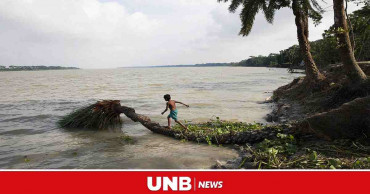Climate risks
'With enough foreign funding, Bangladesh can do more to face climate risks'
Environment, Forest and Climate Change Minister Md Shahab Uddin has said Bangladesh is working to cut down on climate risks not only with foreign aid but also with its funding.
"About Tk3,852 crore has been allocated from the Bangladesh Climate Change Trust Fund set up in 2009 up to the financial year 2020-21. With the fund, ministries, government offices; different organisations and institutions are accepting and implementing more than 850 projects," the minister added.
"Bangladesh will be able to do more to face the risks of climate change if it receives sufficient foreign funding."
Read: Climate shocks have the potential to disrupt food system: Matia Chowdhury
Shahab was speaking at the shadow parliamentary debate competition "COP27 Could Not Reflect the Expectations of Climate Affected Countries" organised by Debate for Democracy in Dhaka Saturday.
The vital United Nations climate talks, billed as one of the last chances to stave off climate breakdown, took place from November 6-18 in Egypt's Sharm El Sheikh amid a multitude of competing crises, including the war in Ukraine, high inflation, food shortages and an energy crunch.
Negotiators spent frantic days discussing whether to formally consider the issue of loss and damage, or reparations, to vulnerable nations suffering from climate change, and the issues, which weighed on the talks for years.
For Bangladesh, climate finance was one of the major topics to be broached at the 27th Conference of the Parties to the UN Framework Convention on Climate Change (COP27).
Read: 7.1 million Bangladeshis displaced by climate change in 2022: WHO
"This year's climate conference decided that climate-affected countries like Bangladesh must be compensated by developed countries. The developed countries will have to deliver on the $100 billion finance per annum that they had promised to provide to the countries hit by climate change earlier."
"Also, the conference decided to create a loss and damage fund, but the source of funding was not determined. This has to be fixed urgently. To implement Bangladesh's Climate Adaptation Plan (NAP) $230 billion is needed," he added.
"Through the implementation of Bangladesh's Nationally Determined Contribution (NDC) 21.85 percent of greenhouse gas emissions will be reduced by 2030 if sufficient foreign funding is received."
3 years ago
Energy-rich Qatar faces fast-rising climate risks at home
At a suburban park near Doha, the capital city of Qatar, cool air from vents in the ground blasted joggers on a November day that reached almost 32 degrees Celsius (90 degrees Fahrenheit).
The small park with air-conditioned paths is an apt illustration of World Cup host Qatar’s answers, so far, to the rising temperatures its people face. The wealthy Gulf Arab nation has been able to pay for extreme adaptive measures like this thanks to the natural gas it exports to the world.
A small peninsula that juts out into the Persian Gulf, Qatar sits in a region that, outside the Arctic, is warming faster than anyplace else on earth.
“It's already bad. And it's getting worse," said Jos Lelieveld, an atmospheric chemist at Germany's Max Planck Institute. Part of the reason is the warming waters of the Persian Gulf, a shallow, narrow sea that contributes to stifling humidity in Qatar during some months.
“It’s a pretty difficult environment. It’s quite hostile,” said Karim Elgendy, an associate fellow at the London-based Chatham House think tank. Without its ability to pay for imported food, heavy air-conditioning and desalinated ocean water, he said, the contemporary country couldn't exist.
Already, Qatar has faced a significant rise in temperatures compared to pre-industrial times. Scientists and others concerned about climate change are trying to keep the Earth as a whole from warming by more than 2 degrees Celsius (3.6 degrees Fahrenheit) on average because research shows it will be profoundly disruptive, making many people homeless, inundating coastlines and destroying ecosystems.
“Qatar has an enormous amount to lose in terms of the effects of climate change,” said Mohammed Ayoub, a professor at the Environment and Energy Research Institute at Qatar's Hamad bin Khalifa University. It is one of the world's hottest countries and will experience even more heat extremes, floods, droughts and sand and dust storms.
CLIMATE PLEDGES
If Qatar is one of the world’s wealthiest nations per capita, it is also one of the most polluting per person. Around this country slightly smaller than the U.S. state of Connecticut, large SUVs are a common sight, filled with cheap gasoline. Air-conditioning blasts the insides of buildings year-round. Even the country’s drinking water is energy intensive, with nearly all of it coming from desalination plants that burn fossil fuel for the force needed to press ocean water through tiny filters to make it consumable.
In recent years, Qatar has inched forward making climate pledges. At the 2015 Paris climate talks, it did not commit to reducing emissions, but set a goal six years later to cut emissions 25% by 2030. One way would be to use carbon capture and storage at gas production facilities, a much-discussed technology that has yet to be deployed at scale.
Read more: COP27: How will UN climate deal on loss and damage work?
Recently, the country also connected a solar power plant to its electric grid that could power 10% of the nation's energy needs at full capacity.
In Doha, there is a new metro system, more green spaces and parks, and the upscale Msheireb district which was designed to take advantage of natural wind flows.
But it's not clear that Qatar can reach its reduction goal in seven years. At the recent U.N. climate conference in Egypt, Qatar’s environment minister Sheikh Faleh bin Nasser bin Ahmed bin Ali Al Thani said the country was “working to translate these ambitions to facts.”
The ministry of environment and climate change did not respond to multiple requests from The Associated Press for comment on its emissions reduction plan.
In the past, it has said that one key effort will be to diversify Qatar's economy.
Many observers say hosting the World Cup is part of branching out from oil and gas to become an entertainment and events destination. But to hold the event, Qatar built enormous amounts of infrastructure over a 12-year period — with a massive carbon footprint, despite its claims otherwise.
“They can’t diversify without spending money,” said Elgendy. "And that money will come from oil and gas. It’s a bit of a conundrum.”
Read more: Qatar World Cup: Biggest party or scam in the world?
GLOBAL DEMAND FOR GAS
Qatari officials and some academics argue that exporting liquefied natural gas to the world can help the transition to clean energy because the fossil fuel is less polluting than oil and coal. That view is increasingly unsupported by science as the extent of leaks from natural gas infrastructure becomes clear. Leaking natural gas is far more harmful for the climate than carbon dioxide, ton for ton.
Earlier this year, state-owned gas giant Qatar Energy joined an industry-led pledge to reduce nearly all methane emissions from operations by 2030. Methane is the the principal constituent of natural gas.
But a real turn away from fossil fuels has yet to begin here.
After Russia's invasion of Ukraine, Europe’s race to replace gas from that country left Qatar — among the world’s top natural gas producers and exporters — in pole position to benefit.
Qatar inked new deals with several energy companies, including a recent 27-year agreement to provide liquefied natural gas to Chinese oil and gas company Sinopec.
“Since the war in Ukraine, everyone is talking to the Qataris now to see if they can get that gas,” Elgendy said.
3 years ago
Continued investment in coastal resilience critical for sustainable growth: World Bank
With increasing climate risks, Bangladesh needs to continue investments to strengthen climate resilience in the coastal zones to protect the development gains, says a new World Bank report launched on Monday.
The report, “Bangladesh: Enhancing Coastal Resilience in a Changing Climate” highlights the country’s journey to reducing vulnerability to climate change and recommends further actions towards improving the resilience of its coastal region.
It analyzes the drivers of risks, how the government has reduced these risks, and offers new perspectives and innovative solutions.
Also read: World Bank to provide US$300 million to help Bangladesh’s pandemic response
Despite vulnerability to climatic risks, Bangladesh has emerged as a global leader in climate change adaptation and is known for proactively investing in resilience. It shows how long-term investments in disaster risk reduction save lives, reduce economic losses, and protect development gains.
This was possible due to a range of initiatives backed up by a strategic policy framework, from grassroot-level adaptation and community-based early warning systems to structural investments in infrastructure complemented by nature-based solutions and fostering innovation. Since independence in 1971, Bangladesh has reduced cyclone-related fatalities by 100-fold.
However, a rapidly growing population, environmental degradation, and increasing climate risks are putting pressure on the existing natural and infrastructure systems in the coastal zone which is home to about 40 million people. Bangladesh needs to take further immediate actions to improve resilience.
“Coastal resilience is not a static goal to be met, but rather a continuous process of adapting to changing conditions and finding synergies between development objectives,” said Dandan Chen, World Bank Acting Country Director for Bangladesh and Bhutan.
“For the last fifty years, the World Bank has supported Bangladesh to build climate resilience and improve disaster risk management. Today, the country shares valuable experience in improving disaster preparedness and climate resilience and is an inspiration for other climate-vulnerable nations,” Chen said.
The report finds that further investments in coastal resilience would produce an array of economic, social, and environmental benefits for Bangladesh.
It lays out seven key recommendations to strengthen the resilience of the coastal region, including strengthening operation and maintenance of infrastructure; recognizing local knowledge; and utilizing state-of-art modeling tools.
Given the changing climate and dynamic coastal processes, a risk management framework should act as the guiding principle for adaptive delta management.
Also read: World Bank happy, congratulates Bangladesh on Padma Bridge
Infrastructure investments need to be complemented with nature-based solutions.
The coastal area can benefit from inclusive community participation and livelihood adaptation for sustainable resilience.
Lastly, establishing an integrated framework that goes beyond risk reduction and includes growth, well-being, and sustainable development at its core.
“Given the significant investment need, we can learn from past interventions and find innovative solutions. This report provides a first-of-its-kind analysis of all large investment projects since the 1960s”, said Swarna Kazi, World Bank Senior Disaster Risk Management Specialist and co-author of the report.
“A key lesson learned is that there is huge potential in Bangladesh for nature-based solutions or hybrid solutions with a mix of green-grey infrastructure,” added Ignacio Urrutia, World Bank Senior Disaster Risk Management Specialist and co-author of the report.
This report complements the forthcoming Bangladesh Country Climate and Development Report (CCDR), the World Bank Group’s new diagnostic report that integrates climate change and development considerations.
Since 1972, the World Bank is helping Bangladesh build coastal and climate resilience and disaster preparedness. The first five World Bank projects committed to Bangladesh in 1972, included support to improve disaster preparedness in the coastal area in the aftermath of deadly cyclone Bhola.
Currently, with an ongoing program of $1.9 billion, the World Bank is helping Bangladesh to build climate resilience through multipurpose cyclone shelters, embankments, early warning systems, weather services, and afforestation.
3 years ago





